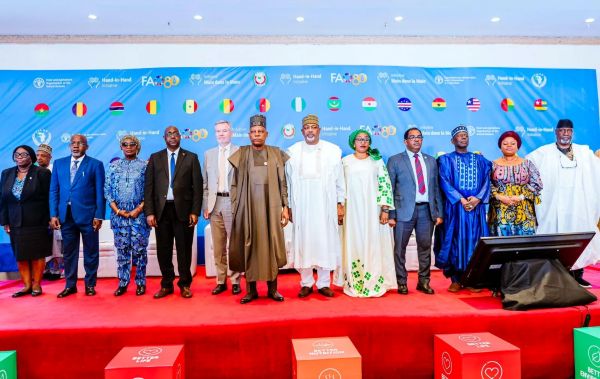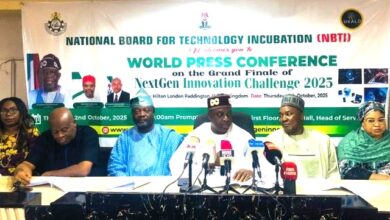FG Unveils Single-Window Land & Agri-Credit; Big Bet on Irrigation and Mechanisation

Abuja — The Federal Government is moving to unlock food production at scale with a single-window platform for land registration, stronger agricultural credit, expanded irrigation, and accelerated mechanisation. Announced at the FAO Hand-in-Hand Investment Forum, the package positions agriculture as the growth engine of the Renewed Hope Agenda—with an explicit push to lower investor friction, boost yields, and crowd in private capital.
Vice-President Kashim Shettima said President Bola Tinubu’s administration is introducing single-window platforms for land registration, strengthening agricultural credit systems, expanding irrigation infrastructure, and scaling mechanisation.
Shettima said this in Abuja on Tuesday during the Food and Agriculture Organisation of the United Nations (FAO) National and Subregional Hand-in-Hand Investment Forum.
He announced fresh incentives to boost agricultural investment under President Tinubu’s Renewed Hope Agenda.
According to him, it is part of ongoing reforms to unlock Nigeria’s vast food production potential through new policies that serve as a game-changer for agriculture and infrastructure investments in the country.
He stated that hunger poses a global security issue, adding that Nigeria must mobilise its strengths to secure a future of abundance.
“Nothing unifies humanity as much as hunger. It is the great equaliser that reveals our vulnerabilities and the shared fragility of our existence.
“Food is not merely a matter of survival, it is a matter of global security. We must facilitate access to land and resources for serious investors.
What’s New
- Single-Window for Land: A one-stop digital route to obtain titles/consents, reduce turnaround time, and cut informality—crucial for using land as bankable collateral.
- Stronger Agri-Credit: Reinforced lending channels for MSMEs and commercial farms, geared to move farmers from financial exclusion to inclusion.
- Irrigation First: Nigeria has river basins and aquifers capable of irrigating 3m+ hectares, yet <10% is currently used. Targeted investment is framed as a yield tripler and hedge against climate shocks.
- Mechanisation at Scale: A shift from drudgery to productivity—tractors, planters, harvesters, and post-harvest equipment to compress costs per hectare and reduce losses.
Framing from the Presidency: Hunger is a security issue; agriculture policy is being rebuilt to attract capital via regulatory reforms, PPPs, and agri-tech adoption.
Development Economics Lens (Why It Matters)
- Bankability via Title: Formal titles and predictable tenure unlock credit, enable insurance uptake, and improve valuation for out-grower schemes.
- Yield & Seasonality: Irrigation collapses seasonality, allowing 2–3 crop cycles, stabilising incomes and improving input supplier economics.
- Cost Curve: Mechanisation lowers unit costs, supporting price competitiveness in grains, roots/tubers, and horticulture.
- Jobs & Poverty Targets: The national blueprint aims to create 21 million full-time rural jobs and lift 35 million people from poverty through deliberate ag-investments.
Execution Priorities (12–24 Months)
- Land Single-Window Go-Live:
- Unified portal with service-level agreements for search, consent, titling and GIS mapping.
- Interoperability with state land registries and BVN/NIN for KYC.
- Unified portal with service-level agreements for search, consent, titling and GIS mapping.
- Credit that Works:
- Risk-sharing with PFIs, warehouse-receipt finance, and performance-based incentives for lending to women and youth.
- Bundled products: credit + insurance + extension + markets.
- Risk-sharing with PFIs, warehouse-receipt finance, and performance-based incentives for lending to women and youth.
- Irrigation Roll-Out:
- Prioritise shovel-ready river basin schemes; expand smallholder drip and solar pumps where large schemes lag.
- Water-user associations for O&M discipline and tariff collection.
- Prioritise shovel-ready river basin schemes; expand smallholder drip and solar pumps where large schemes lag.
- Mechanisation Hubs:
- PPP service centres (pay-per-hectare) rather than public tractor giveaways.
- Local assembly/parts ecosystems to keep machines available and affordable.
- PPP service centres (pay-per-hectare) rather than public tractor giveaways.
- Market Access & Post-Harvest:
- Cold chain and aggregation for horticulture; standardized grades for grains; off-take contracts that de-risk farmgate pricing.
- Cold chain and aggregation for horticulture; standardized grades for grains; off-take contracts that de-risk farmgate pricing.
Risks & Mitigations
- Land Federalism: Different state processes can blunt a national single-window. Mitigation: federal-state MoUs, harmonised fees, KPI dashboards.
- Credit Leakage/Defaults: Poor targeting or political loans impair PFIs. Mitigation: data-driven underwriting, crop-cutting data, and claims-paid insurance history.
- Irrigation O&M: Schemes decay without governance and tariffing. Mitigation: community-led O&M and enforceable service contracts.
- Mechanisation Downtime: Idle tractors kill unit economics. Mitigation: private operators, spares logistics, technician training, and telematics.
Investor Signals
- Policy Re-engineering: Government is “open for business”—using PPPs and regulatory clarity to crowd in capital.
- The FAO Angle: Hand-in-Hand provides a country-led investment pipeline, aligning development partners and private financiers.
- Sub-sector Hotspots: Rice, wheat, maize, soy, cassava, tomatoes, onions, dairy and poultry—where irrigation + mechanisation deliver fast yield wins.
By the Numbers (Targets & Context)
- Irrigable land: 3,000,000+ ha potential; <10% currently utilised.
- Jobs: 21 million full-time rural jobs (blueprint target).
- Poverty: 35 million people to be lifted from poverty via agri-investments.
- Policy bedrock: National Development Plan (2021–2025); Renewed Hope Agenda.
BRANDECONOMY Take
The combination of bankable land, fit-for-purpose credit, water control, and machines in the field is the shortest route to lower food inflation and higher rural incomes. If the single-window truly cuts red tape and irrigation is executed with O&M discipline, Nigeria’s yield curve shifts within two seasons—and private capital follows.
Bottom line: Fewer forms, more farm. Make land bankable, water reliable, and credit usable—and agriculture becomes Nigeria’s most investable story.











